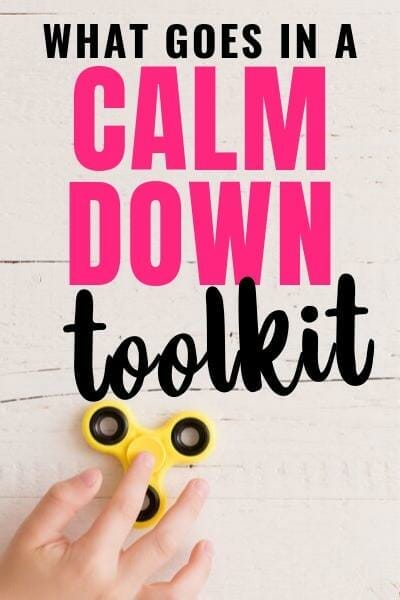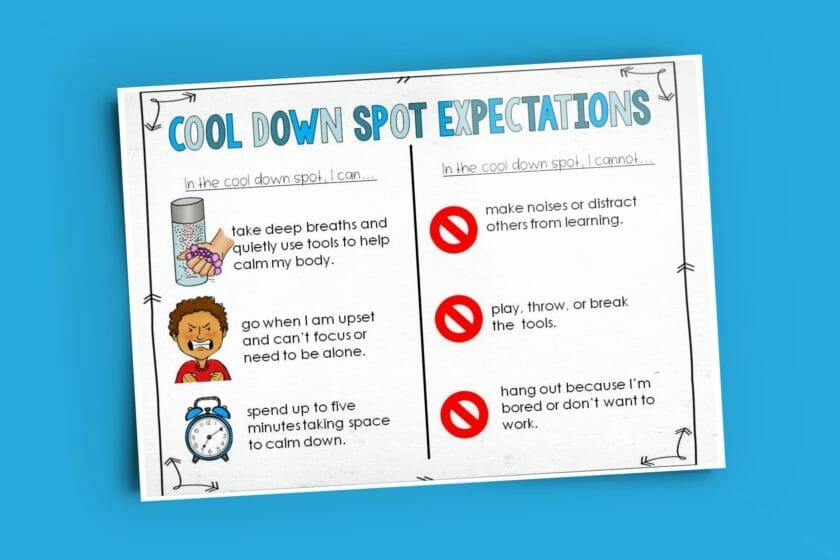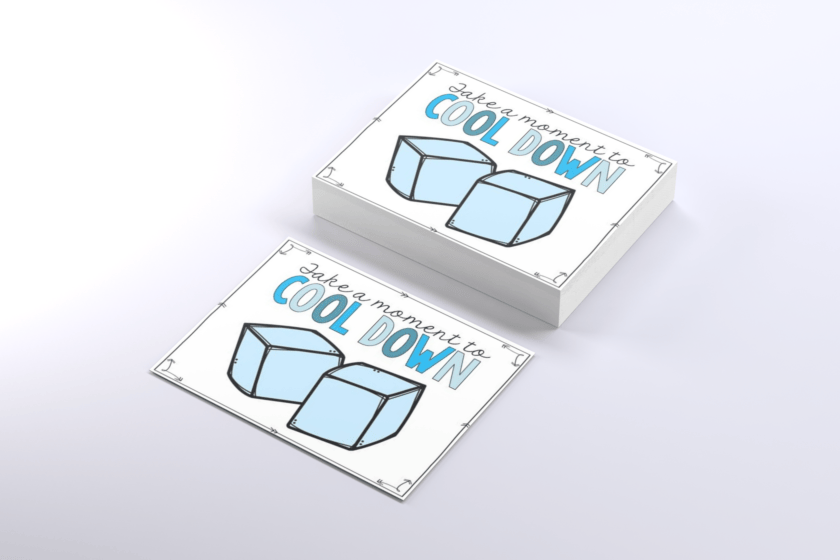Cool Down Spots in the Classroom: Your Questions Answered
Each year I would have at least one student who struggled to manage his or her emotions in my classroom. This often led to tears, frustration, and required me to make significant adjustments to our learning environment. One of the best adjustments was the addition of a quiet calm down corner or cool down spot, and it was perfect for students who needed frequent breaks or needed a place to go where they could regroup.
I found this space helped me keep kids in class while still allowing them the break they needed to return to learning. Often students who need frequent breaks or struggle with emotional regulation are removed from class even when their behavior isn’t dangerous. Offering a space within the classroom can afford these students the opportunity to access learning that they may have otherwise missed, so today I wanted to share more about what this space is and how you can quickly and inexpensively create one in your classroom.

What is a calm down corner?
A calm down corner, also called a calm down, cool down spot, or peace corner, is a designated place where students can go when they are feeling overwhelmed or upset. The purpose is to create a safe space where kids can practice self-regulation skills and work to calm themselves.
A cool down corner is not designed to be used as a punishment. Instead, it is designed to be a space that offers students a break from frustration and stress while they work to recover composure.
Why create a calm down corner in your classroom
Academic learning time, or the amount of time students spent on-task and learning, is strongly correlated with positive outcomes for kids. This means that we need to aim to keep kids in class as much as possible. However, this is not always easy. Students come to us with all sorts of background experiences, needs, and skill levels. These all contribute to how well students are able to function and handle the demands of the classroom.
Many students who struggle to control their emotions are constantly in fight or flight mode. These students might be quick to anger or meltdown frequently. Creating a calm down corner can help give these students a safe place and the tools they need to begin to self-regulate.

A cool down spot can also be a helpful transition for students who might be currently taking frequent breaks or walks outside of the classroom because they struggle with focus or sensory stimulation. This space can be a step toward more time in class without sacrificing the necessary breaks these students need.
How to create a calming corner in your classroom
Getting started setting up your cool down spot
Creating a calm down or safe spot in your classroom can be a simple and inexpensive process. While you might consider investing in a bean bag chair to make the space cozy, this is not necessary. There are many inexpensive ideas for setting up your classroom calmdown corner.
Here’s how to set up a calm down corner in your classroom:
- Select a spot in your classroom that is not in a high-traffic area. While you don’t need a large space, make sure there is room for a student to move a bit and the area is relatively free from distractions.
- Use a small rug or seating to define the space and create a comfortable spot for students.
- Add a calming box or toolkit with sensory tools and fidgets that can help students refocus and decompress from the stress they were feeling. Consider adding a visual timer if you feel students may be likely to abuse the space.
- Add purposeful decorations and signs to help students select and utilize calming strategies.
What to include in your calming box or kit
If you’re new to the process of creating a calming corner, you might wonder what you should put in your calming box.
The answer most definitely is not one-size-fits-all. However, here are some tools that are often helpful for students:
- Fidget toys or stress balls
- Stuffed animal(s)
- Sensory bottles
- Music with headphones
- Paper and crayons or pencils
- Writing board
- Slime, modeling dough, silly putty, or kinetic sand
You can find great cheap sensory items at Dollar Tree. Alternatively, you can invest in higher quality items like these sensory balls from MindPanda that will last longer.

What to put on the walls in your calming corner
Any signs you put up in your calming corner should be purposeful. Consider signs that will help students self-regulate, identify emotions, and calm down. The quiet corner should be a calming area where the focus is on feeling safe and applying strategies for managing big feelings.
Here are some signs you might include:
- A way to non-verbally express their feelings (visuals of feelings that students can point)
- Breathing techniques
- Expectations or options of what students can do in the space.
- Problem-solving strategies
- Strategies for interacting with peers or dealing with bullying.
Below I’ll share a couple of examples of each to help you get started.
Breathing Techniques Posters
This can be a great way to help students slow their breathing and relax. Two of my favorites are hot cocoa breathing and star breathing. After I taught these strategies to students, I created posters for each of these breathing exercises to keep hung in our calm down space.

Expectations for the Cool Down Spot
Since I feel like it is important to have expectations clearly posted for students, I also created a poster so that we could regularly refer to them in class.
Here’s what the expectations looked like in my classroom:

Free Calm Down Area Starter Kit
I’ve included the three posters above in my FREE Calm Down Spot Starter Kit. In addition to the posters, you’ll also get a visual feelings chart and cool down passes to non-verbally let students know they might need a break.
How to teach your students to use the calm down center
Before you implement this system into your classroom, it will be important to teach the process to your students explicitly and give them opportunities to practice using the sensory or calming tools you have selected.
You can do this with your full class when you first introduce the space to the children, but you should also plan to do this individually with students who might need to utilize the space regularly.
Spending time on this process can help reduce the likelihood that students misuse the area or become dependent on breaks in the space. Here’s the basics of what you’ll want to discuss:
- When to use the classroom cool down spot
- How students will let you know they need a break
- How to transition to the spot – behavior expectations
- What to do when they arrive – selecting a sensory or fidget tool, using a breathing strategy, etc.
- Teacher check-in process – what you’ll ask or discuss
- How to transition back from this spot
- Any limits, special situations, etc.
Troubleshooting Issues with Your Cool Down Space
While most teachers find that the calm down corner is a great addition to their classroom, sometimes challenges arise. Here are some frequently asked questions:
What do I do if my students won’t use the calm-down space?
If you find that students are not using the space, you may want to begin by reteaching and modeling how to use this space. If your school has a counselor, you can also ask them to teach a lesson about the calm down space and some strategies to use while there.
Some students may not have the self-awareness to notice when they are escalating or overstimulated. In this case, you may want to implement a teacher-directed break while you work with the student to begin developing self-regulation skills.
One great way to initiate the break is to give the student a cool down pass. This allows you to avoid verbal confrontation, but it allows them to go and take space. Your cards don’t need to be fancy, and I’ve included a free set in the Cool Down Area Starter Kit.

How do I stop students from spending too long in the cool down space or using it to avoid work?
Some students may begin using the cool down space as an escape from non-preferred tasks rather than as a tool to help them self-regulate. As with any new option you add to your classroom, you can expect that student use will decrease over time. Therefore, if it isn’t causing major issues, you may decide to give it a few weeks to see if the behavior continues. As the newness wears off, you might notice the student using the area less frequently or having shorter stays.
However, if you’ve given some time or your cool down space isn’t new and you still notice a student spending long periods of time or heading there too often when they appear to be doing fine emotionally, you may want to consider using a timer to regulate the amount of time the child is spending there. When the timer goes off, you can check in with the student and have them return to their work.
You can also offer the space as a break for finishing a specific task – either a certain number of problems or number of minutes on task.
You may also want to consider whether you’ve provided too many tools in the space. When this happens, it can become playtime vs. time to regain composure. Therefore, you might consider removing a few tools to see if that helps.
What if the student doesn’t like the cool down corner?
You’ll want to make sure you introduce and give the student some time in the calm down corner before they are upset. This makes the area feel like less of a punishment and more of an opportunity to reflect and decompress.
You’ll also want to ensure you’ve included sensory items that the student is interested in or likes to use. When there is nothing of interest in the area, a student is less likely to seek out the cool down area to help them when they are in a heightened state.
See it in action
Once you’ve created your cool down space and have taught the procedures, students can go to this safe space when they become angry, frustrated, or upset. This can prevent meltdowns or outbursts when students are overwhelmed with these big feelings. It can also help prevent power struggles when students shut down and are not receptive to redirection.
When students know what the cool-down space is and its purpose, they are more likely to use it during these tough times. Not only can a cool-down space provide a safe place for the student to cool down, but it can also provide tools and strategies to help the student.
Here’s a great video about how cool down spaces, which they call a Peace Corner, have worked for one campus:
Grab Your Free Cool Down Spot Starter Kit
It is important for teachers to create a cool-down space in their classrooms to assist students in regulating emotions, utilizing techniques and strategies to calm down, and problem-solving.
The cool-down space doesn’t have to be anything fancy or cost a lot of money. With a little time and creativity, one can be created. The cool-down space can be a lifesaver for teachers and their students.
Grab the freebies to get started creating your cool down space today!






